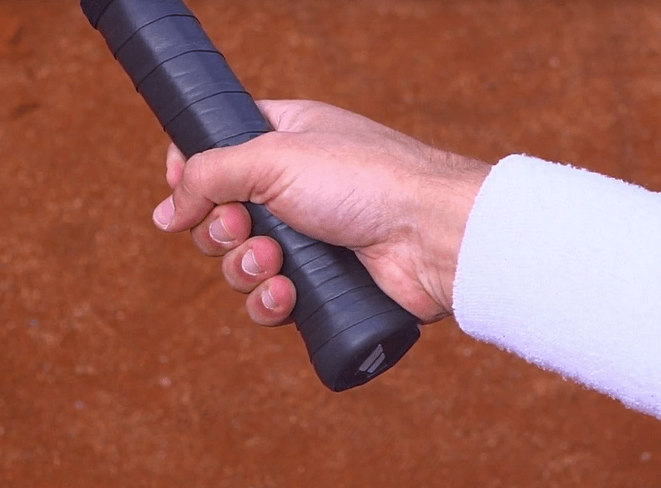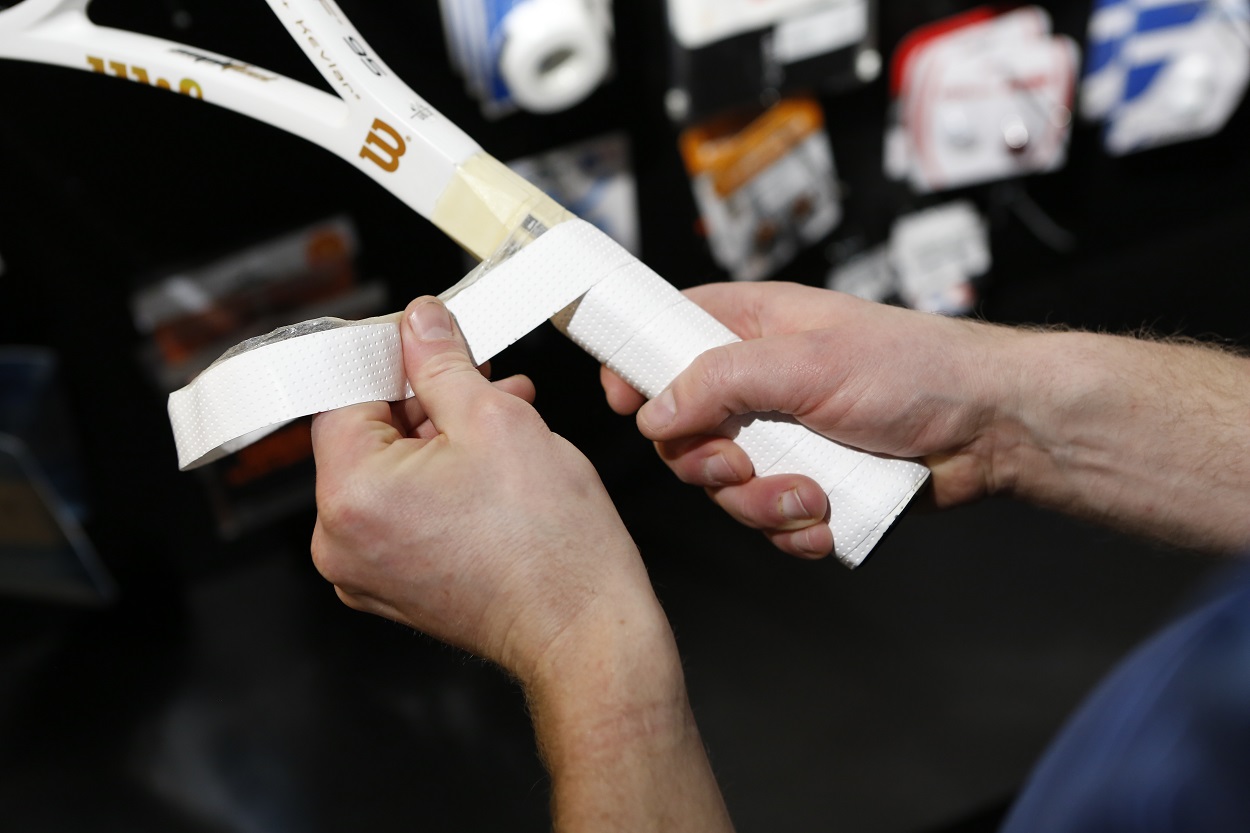TOPSELLER DEALS Bespaar tot wel 60% op meeer dan 300 bestsellers. Spar nu.
Grip strength

How can you determine the grip strength?
The matching grip size is enormously important. It not only helps you get the most out of your racket, it also protects you from injury. The grip size can be determined by grasping the tennis racket with the striking hand in the forehand grip. The little finger of the other hand should now fit exactly between your fingertips and your palm. In case of uncertainty regarding the correct grip size, choose the smaller size.
Rule of thumb: There should be room for the little finger between the fingertips and the palm of the hand when surrounding the handle.
Rule of thumb: There should be room for the little finger between the fingertips and the palm of the hand when surrounding the handle.
The grip band
What is there for grip bands?
There are two groups of grip bands: the baseband and the overgrip.
The baseband is present on each racket from the beginning. This grip band is available in different thicknesses from 1.5 to approx. 2.5 mm. Most basic grip bands are between 1.8 and 2.0 mm.
The overgrip or overband is wrapped over the existing baseband. Also this grip is available in different thicknesses from 0.4 to 0.8 mm.
The baseband is present on each racket from the beginning. This grip band is available in different thicknesses from 1.5 to approx. 2.5 mm. Most basic grip bands are between 1.8 and 2.0 mm.
The overgrip or overband is wrapped over the existing baseband. Also this grip is available in different thicknesses from 0.4 to 0.8 mm.
Which functions do grip bands have?
The grip tape as a baseband has several tasks:
- By choosing the baseband, the grip size can be adjusted.
- Depending on the thickness and hardness of the strip material more or less strong vibrations can be damped. The thicker and softer, the stronger the cushioning. Thinner and harder attenuates accordingly less, but offers more feedback.
- Absorbs a large part of the vibrations - The baseband takes over the main tasks when absorbing the hand sweat.
- For players who play without overgrip, the baseband creates the grip through the surface quality.
The baseband is already on the racket. All properties of the baseband are subject to wear, so that a regular check and possibly the replacement of the baseband is urgently recommended.
The application should be done professionally, as the function can be impaired if not. The main task of the Overgrip is to create a comfortable grip. Here, a distinction can be made between "dry overgrips" and "sticky overgrips":
The application should be done professionally, as the function can be impaired if not. The main task of the Overgrip is to create a comfortable grip. Here, a distinction can be made between "dry overgrips" and "sticky overgrips":
- Dry overgrips should be used if you sweat quite a bit, otherwise "drying out" of the hand can lead to blisters or chafing. When new, the bands feel rather rough and dry.
- Sticky overgrips are often called "tacky". These are more or less adherent and have a smooth surface. Both grades complement the existing baseband by absorbing the hand sweat and providing improved cushioning. Since they have no adhesive film, anyone can easily change the wrapping without damaging the tape. In principle, it is important to regularly replace both types of grip bands.
How to wrap a grip tape?
Regardless of whether it is a basic grip or an overgrip, basically the attachment of the two grip bands works the same. With the base grip band, application is only a little bit more complicated because the self-adhesive backside makes post-correction more difficult.
Step 1: Unpack
When you buy a grip band, you usually get it rolled up in a small package. An adhesive strip is wrapped around this packet. These grips are in the majority of cases "whole grips", that is, they are sufficient for the complete grip. This is especially important for the players who play an ambidextrous backhand and use the full club grip.
Take the package and carefully remove the tape. Please do not throw this tape away, but put it aside safely. This is the finishing band, with which the grip band is later fixed on the racket. Unwind the grip and remove the protective film from the top.
When you buy a grip band, you usually get it rolled up in a small package. An adhesive strip is wrapped around this packet. These grips are in the majority of cases "whole grips", that is, they are sufficient for the complete grip. This is especially important for the players who play an ambidextrous backhand and use the full club grip.
Take the package and carefully remove the tape. Please do not throw this tape away, but put it aside safely. This is the finishing band, with which the grip band is later fixed on the racket. Unwind the grip and remove the protective film from the top.

Step 2: Prepare
The grip band has two different ends - a normal wide end and an obliquely cut end. The obliquely cut end is used during application. There is also a small adhesive dot on the back, with which the grip on the racket can be fixed, which facilitates the "procedure". When applying, start at the lower, wider end of the handle and wind the tape up towards the club head. Each grip is delivered from the factory for right-handed people.
The grip band has two different ends - a normal wide end and an obliquely cut end. The obliquely cut end is used during application. There is also a small adhesive dot on the back, with which the grip on the racket can be fixed, which facilitates the "procedure". When applying, start at the lower, wider end of the handle and wind the tape up towards the club head. Each grip is delivered from the factory for right-handed people.
Before you fix the grip on the racket and get started, you should pay attention to a little thing: If you want to wrap an overgrip over an already existing band, you have to pay attention on which side of the grip you start. If you take a closer look at the existing grip band, you can see that it is slightly thicker on one side of the club end than on the other side. The thicker side is created by crossing the original tape once before winding it up. Since this happens when you wrap each grip, you should start wrapping on the thinner side to make the grip about the same thickness on both sides.
Step 3: Wrap
Now you can start with the actual application. For this you stick the grip tape with the cut end on the racket. Note that there are differences between left and right-handers. Left-handers wrap the grip around the left, right-handers around the right. If you attach the grip strap to the racket so that the cut end points down (away from the club head), it will be easier to wrap. This is how you automatically get into the slightly sloping guidance of the grip band and can wrap it more easily.
Now you can start with the actual application. For this you stick the grip tape with the cut end on the racket. Note that there are differences between left and right-handers. Left-handers wrap the grip around the left, right-handers around the right. If you attach the grip strap to the racket so that the cut end points down (away from the club head), it will be easier to wrap. This is how you automatically get into the slightly sloping guidance of the grip band and can wrap it more easily.

First of all, you have to wrap the tape around the end of the racket under light pressure. Once you're around you can already see how the grip automatically goes into a slightly oblique winding. Now continue to wind the band, always under light pressure, around the racket. It is important that the sides of the grip band always overlap slightly when winding (about 1.5mm). Many grip bands have a slight notch on the sides for this.
Step 4: Complete
If you have wrapped the grip tape up to the top, there are two ways to complete the winding. Either you cut off the rest and then fix the grip tape with the end band (see step 1) on the racket or you fold the protruding tape in the middle, turn it in slightly and wrap the tape completely finished. Again, the end of the grip band is fixed with the end band. Some rackets also come with a rubber band that you can slide over the shoulder strap for safety. This gives extra grip.
If you have wrapped the grip tape up to the top, there are two ways to complete the winding. Either you cut off the rest and then fix the grip tape with the end band (see step 1) on the racket or you fold the protruding tape in the middle, turn it in slightly and wrap the tape completely finished. Again, the end of the grip band is fixed with the end band. Some rackets also come with a rubber band that you can slide over the shoulder strap for safety. This gives extra grip.
How important is a fresh grip band?
A fresh grip band is very important for optimum grip and playing comfort. In addition, it ensures a comfortable lying of the racket in the hand. The regular changing of the grip band should be routine. We recommend a white grip band, as this does not get any color pigments and you can see if this is dirty. The grip band should then be changed if the grip noticeably declines or if the uppermost layer of the grip band already shows slight signs of wear. A reliable rule of thumb for a time does not exist. At the latest when colour changes the gripband should be changed.






















